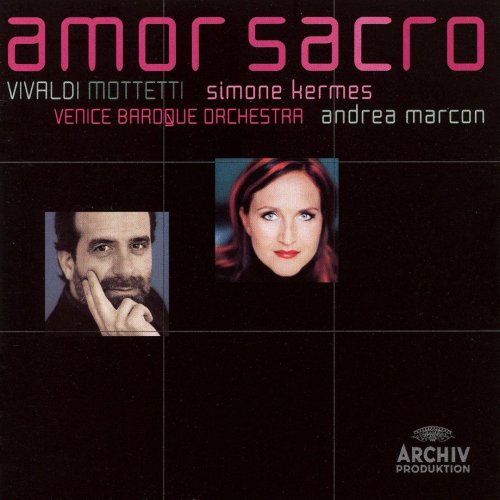Simone Kermes, Venice Baroque Orchestra, Andrea Marcon - Amor Sacro: Vivaldi mottetti (2007)

Artist: Simone Kermes, Venice Baroque Orchestra, Andrea Marcon
Title: Amor Sacro: Vivaldi mottetti
Year Of Release: 2007
Label: Deutsche Grammophon
Genre: Classical, Vocal
Quality: FLAC (image+.cue,log,scans)
Total Time: 01:07:36
Total Size: 424 Mb
WebSite: Album Preview
Tracklist: Title: Amor Sacro: Vivaldi mottetti
Year Of Release: 2007
Label: Deutsche Grammophon
Genre: Classical, Vocal
Quality: FLAC (image+.cue,log,scans)
Total Time: 01:07:36
Total Size: 424 Mb
WebSite: Album Preview
01-04. In furore iustissimae irae, RV 626
05-08. Nulla in mundo pax sincera, RV 630
09-12. In turbato mare irato, RV 627
13-16. Sum in medio tempestatum, RV 632
Performers:
Simone Kermes, soprano
Venice Baroque Orchestra
Andrea Marcon, conductor
Vivaldi's so-called motets, in this case more accurately described as solo cantatas, are gaining favor among singers with their mixture of vocal athleticism and fervent sacred texts. They are more operatic than Bach's cantatas, with a vocabulary of operatic effects deployed to illustrate religious ideas (ocean storms stand in for trials of the soul, for example). Each of the four motets here, although they come from different phases of the composer's career, features a pair of da capo arias, one fast and one slow, whose dimensions would not seem out of place in an opera of the early eighteenth century, and all give soprano Simone Kermes room to work. Her voice is medium-sized, careful, and slightly piercing rather than sweet. She is at her best in the slower pieces, with the pastoral opening aria of "Nulla in mundo pax sincera, RV 630," a standout example of vocal control and tension matched by exquisite hovering effects from the Venice Baroque Orchestra under Andrea Marcon. In the big, high-speed arias, such as the opening "In furore iustissimae irae" with its evocation of divine judgment, there are other singers who may execute slightly cleaner turns around Vivaldi's high-speed tracks. Kermes is always expressive and charismatic, however, and for listeners familiar with the music her interpretation will find a place on the shelf. No texts are given, in any language, which is very disappointing in a new release by a "major" label; the booklet notes correctly lay strong emphasis on Vivaldi's approach to text-setting, which is important both in terms of the many pictorial effects employed and equally in relation to the deeper question of what kind of religiosity motivated the Red Priest in the shaping of these showy yet impassioned works.








